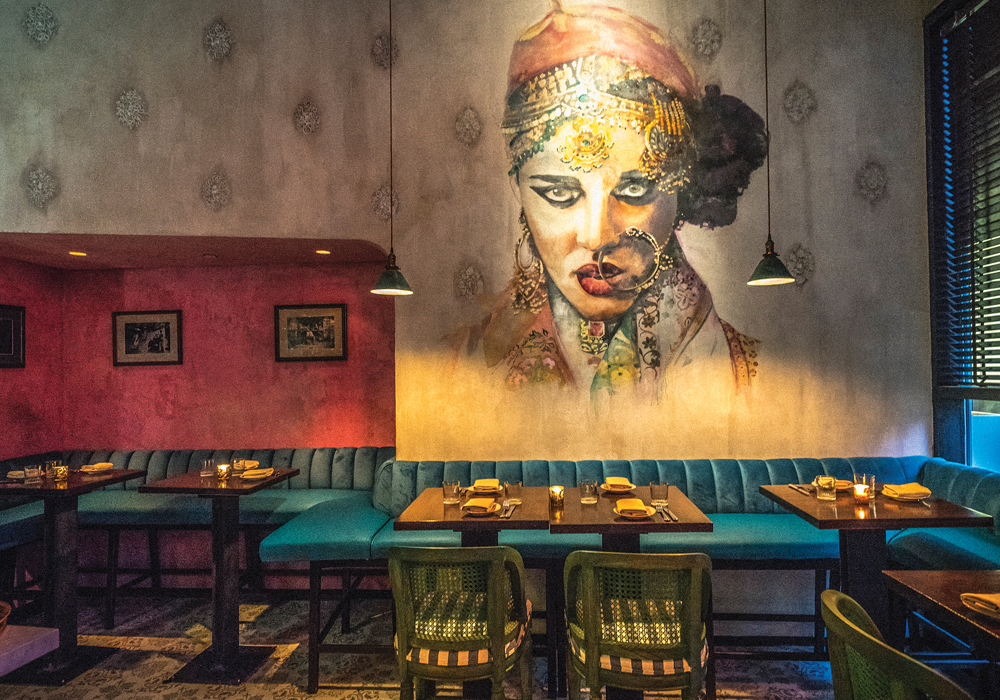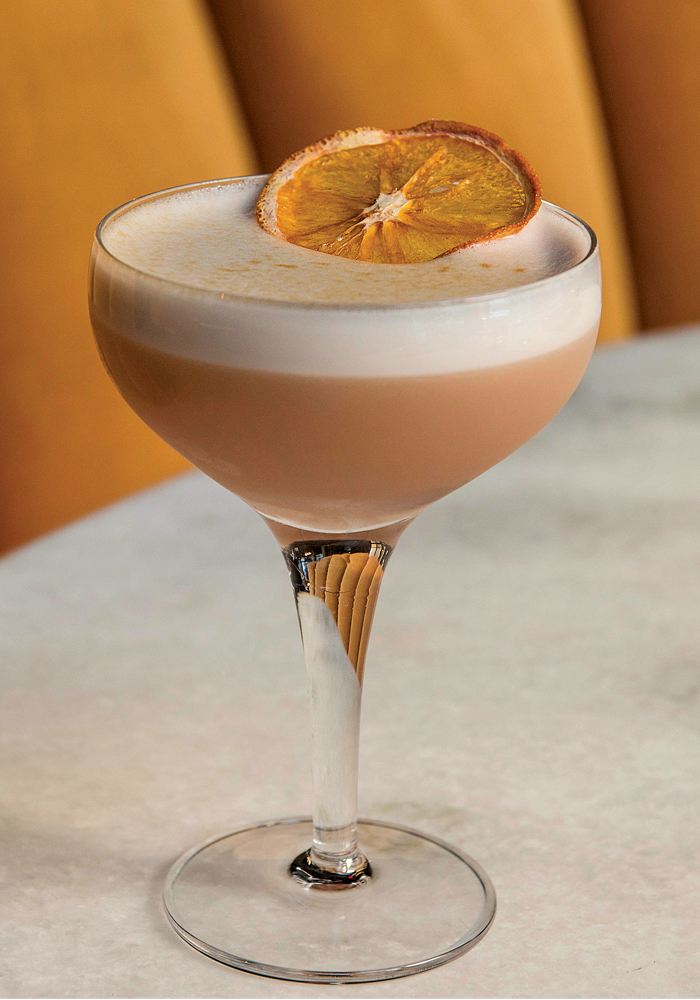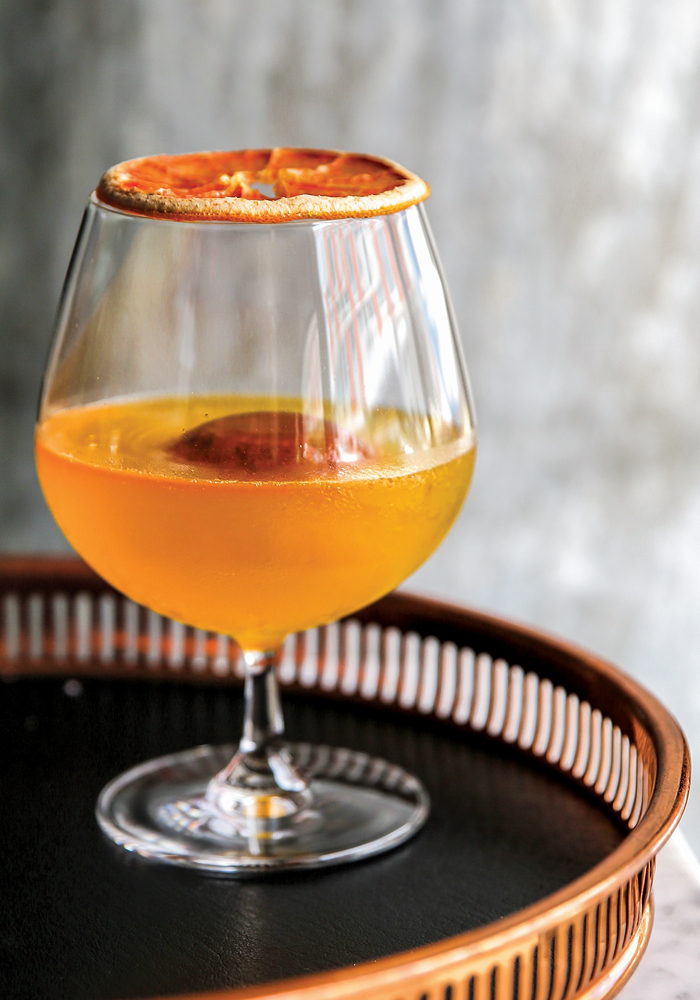Editor’s Note: As so many beverage alcohol trends begin at bars and restaurants, we occasionally cross-post content like this from our sister publication, Cheers, which covers the on-premise scene. Enjoy!
Whiskey is truly a global phenomenon; virtually every country in the world produces and consumes the venerable brown spirit. Demand for whiskey keeps growing, and the category expands as new global regions, styles and brands emerge.
“American whiskeys are booming, and Scotch and Irish whiskies remain hugely popular, but Japanese whiskies have been really trending,” says Noe Vasquez, food and beverage manager for Adelina’s Bistro in Nipomo, CA. The signature restaurant at the Monarch Club within Trilogy at Monarch Dunes golf resort community boasts a selection of more than 225 whiskeys; about 45% are imports.
Adelina’s Bistro displays rare casks and exclusive bottles on a tall tower behind the bar, grouped by style and country. The collection includes Komagatake, a rare Japanese single malt from a tiny distillery, which sells for $100 an ounce; and Teeling 24-year-old Irish whiskey finished in Sauterne barrels. “We have a few adventuresome guests who want to try shots no matter what the price,” says Vasquez.
Golden age
Whiskies from all over are flourishing in the U.S. market—both American and imports.
American whiskey—bourbon, rye and Tennessee—volume was up 5.9% in 2018 and revenue increased 6.6% to $3.6 billion, according to the Distilled Spirits Council of the U.S. (DISCUS). American rye whiskey has taken off considerably, zooming 15.9%, albeit from a small base; while the American single malt subsegment is an accelerating trend, according to DISCUS.
Among the old guard imports, Scotch whisky (as the spirit is spelled in Scotland, Canada, Australia, Japan and Europe) is still king: single malt revenue in the U.S. increased 9.4% and blended whisky revenue rose 4.6%, according to DISCUS.
Much of the action occurred at the superpremium shelf. Irish whiskey continues its stellar growth arc; volume rose 10.2% and U.S. revenue grew 12.0%.
Emerging Regions
But questing bartenders and curious whiskey aficionados are exploring the wider world for new whiskey experiences. Promising newcomers include Sweden, Wales, England, South Africa, Belgium and France—to name just a few. Mexican whiskey is a thing, too; the Sierra Norte brand is fermented from Oaxacan corn.
Australia is now becoming known for its whisky, especially those hailing from Tasmania.
Asia is hot, with India, Taiwan and especially Japan all producing noteworthy examples. Indian whisky was traditionally fermented from molasses, but Amrut broke convention to release a barley malt in 2004; other notable brands include Paul John and Rampur. Kavalan whisky from Taiwan has been winning accolades.
Japanese whisky has been creating the biggest stir now that more examples can be found in the U.S. market, albeit often pricy and highly allocated. Suntory and Nikka are perhaps the best-known producers.
Terroir Tales
Just as with wine, whiskey can express a sense of place. The soil and terrain where the grains are grown, as well as the water sources, contribute to unique flavors and aromas. The climates where barrels mature also have impact; whiskies in cold climes such as Scotland and northern Japan take much longer to age than those in hot areas such as India or Mexico.

“Terroir is probably the most important element affecting styles, along with the corn and barley used,” says Salvatore Tafuri, bar director at The Times Square Edition Hotel in New York. “The factors are truly endless, from the location of the distillery and type of barrel used for aging, to the water used in the process.”
For example, he says, “Japan’s pure water creates a signature taste. In Scotland, the location of the distilleries will affect the style of the whisky.”
Tafuri oversees beverage programs at the hotel’s venues that include the 701West fine-dining restaurant and bar, the Paradise Club, The Terrace and Outdoor Gardens, and the Lobby Bar. He carries about 40 different whiskey brands; half are imports. Shots or sips range in price from $16 to $450; the most popular calls are for Japanese whisky.
“Each region produces different flavor profiles, from nutty and fruity to toasty and cinnamon-like. Water, yeast and grain in the environment all determine what kind of profiles these regions can create,” says Meski Teshome, bar manager of Southern Art and Bourbon Bar (shown atop) in the InterContinental Hotel Buckhead in Atlanta. The restaurant serves Southern classics and features an artisanal ham bar and vintage dessert table.
The Bourbon Bar, naturally, focuses on bourbon. But the 70 whiskies carried includes several imports, such as Johnnie Walker, Balvenie, Macallan and Japanese malts. Whiskey prices range $12 to $30, and rare labels include Elmer T. Lee Bourbon, W.L. Weller 12-year Bourbon, Michter’s 10-year Single Barrel and Yamazaki 12-year Single Malt.
All Around the World
“The emerging regions for global whiskies are mainly India, Taiwan and Japan. In fact, India has one of the highest number of whisky drinkers, and brands like Amrut and Paul John have won awards and are popular globally as well,” says Chetan Gangan, head mixologist at Baar Baar in New York. Baar Baar is an Indian gastro bar; in Hindi the name means “again and again.”

Gangan carries more than 100 different whiskies with categories including rye, bourbon, blended whisky and single malts; countries represented include the U.S., India, Japan, Canada, Ireland and Scotland. Among the several Indian brands are the entire Amrut series. Whisky shots range from $10 to $50.
“Non-traditional whiskies that aren’t following rules are what is driving interest in new whisky regions,” says Gangan.
Private Stock
Restaurant and bar operators looking to wow customers and develop a reputation among whiskey lovers now delve into private-label stock. This often involves partnering with a distillery and tasting samples to develop a unique, custom-blended barrel, which is then bottled with proprietary logoed labels. U.S. establishments typically team with an American distiller, but some operators are looking further afield.
Adelina’s Bistro boasts its own private-label selection of Elijah Craig whiskey aged exclusively for the club. “Our guests love it,” says Vasquez. What started as an entire barrel is now down to just 20 bottles.
Vasquez is considering sourcing another barrel of whiskey, but partnering with a different distillery, perhaps Irish, Scotch or even Japanese to intrigue guests. “A lot of our regulars are really into whiskey and they come in asking what’s new and different.”
Southern Art & Bourbon Bar has partnered with Four Roses to produce Bourbon Bar’s Private Label Aged Four Roses, which is one of the top-selling whiskeys, says Teshome. The private-label bourbon stars in the Whiskey Rebellion cocktail, mixed with Pimm’s and fresh lemon juice.
At The Times Square Edition, Tafuri showcases a bespoke John Fraser Restaurants Maker’s Mark Single Barrel Bourbon, named for restaurateur John Fraser who helms the hotel’s food and beverage outlets. The bar director has also assembled a Ghost Distillery list, which contains whiskeys from distilleries that are no longer in operation. Once these whiskeys are consumed that’s it, there is no more.
Global Cocktail Twists
At Baar Baar, Gangan has created a list of one-of-a-kind cocktails inspired by the vibrant culture, art and spirit of India and influenced by New York’s craft cocktail scene. One is the New Delhi Sour, a reinvented classic made with Medley Brothers 102 Proof Bourbon, rose-hip shrub, citrus juice, egg white and bitters.

Another is the Calcutta Cup, a twist on the Penicillin, mixing Michter’s Bourbon, Isle of Skye 8-year Scotch, curcuma amada (a spice from Calcutta with a mango-ginger flavor), citrus juice, honey and grapefruit bitters. And the Kahwa-Chai is, Gangan’s take on the Kashmiri Kahwa—a classic drink from the Himalayan valley, made with Hudson Maple Cask rye, anandini firdaus tea, grapefruit-ginger syrup, saffron and whole Indian spices.
One of the most unusual whisky cocktails, the Som Ras, uses ghee-washed Amrut Single Malt and Torres 15-year Reserva Spanish brandy as a base, combined with Giffard Banane du Brésil liqueur and bitters. The cocktail is an homage to an ancient Indian spirit with a sordid past that was considered both a mortal sin and a spiritual offering of the highest order.
Baar Baar’s summer cocktail menu included a few whiskey cocktails. One of Gangan’s favorites is called Khubani Panna and consists of blended whisky, Laphroaig Single Malt, burnt apricot puree and egg white. Another is a Ghee Old Fashioned, which consists of ghee-washed bourbon, salted jiggery syrup and Angostura bitters.

Adelina’s Bistro offers an extensive selection of barrel-aged cocktails, including a Rusty Nail (which uses Monkey Shoulder Scotch), a Sazerac, the Monarch Club Manhattan and a Whistle Pig Old Fashioned. Under the House Crafted section is the Old-Old Fashioned: an Angostura bitters-soaked sugar cube with Buffalo Trace bourbon served over a large rock cube and garnished with an orange peel. The signature Fields Of Lynchburg cocktail combines Jack Daniel’s, Jack Daniel’s Honey, lavender bitters and fresh lemon juice. Vasquez is developing two new barrel-aged cocktails using Japanese whisky and Irish whiskey.
Also on Adelina’s menu are the Rye Revenge, made with Dickel rye, Osborne amontillado sherry, creme de poire and barrel-aged bitters; and Liquid Luck, a mix of Tin Cup Colorado whiskey, Lillet, hibiscus syrup, barrel-aged bitters and Angostura bitters. Summer seasonals included the Bourbon Peach Smash.
The Governor is the Bourbon Bar’s main specialty cocktail, which is a riff on an Old Fashioned. It’s made with Four Roses, black walnut bitters, orange bitters and garnished with a flamed orange peel to add flavor and a visual experience.
Rolling On
“Due to the variety of different styles of whisky available, you can truly pick the right option for the flavor profile you are trying to complement, such as smoky, nutty, etc.,” says Tafuri. “I am working with Ohishi sherry cask at the moment, which is a rice whisky that is perfect for a Manhattan variation.” At the hotel’s Lobby Bar, the Arigato Sour mixes blended Japanese whisky, kabosu citrus, elderflower, plum gin and egg white.
The cocktail program at the hotel’s Paradise Club specializes in large-format drinks designed to be shared. Part of the cabaret’s spectacle is the Manhattan trolley. From the rolling cart, a bartender customizes versions of the classic cocktail using the private-label Maker’s Mark Single Barrel bourbon, El Tesoro tequila or rye whiskey, along with house-blended vermouth and a flight of house-made cocktail cherries, each with its own flavor essence.
Next Steps
“We are working on a selection of barrel-aged cocktails,” says Teshome, citing an amazing flavor profile created by the aging in the wood. Then the next step is creating draft cocktails to meet rising demand with consistent quality.
“We also host many events for holidays, local happenings and private parties,” Teshome adds, “all while pairing up with great distillers and vendors to bring whiskey to the center of our guests’ attention.”
Although Adelina’s Bistro offers whisky flights, “lately I’ve been working with the chef to create pairings with food and whiskeys as a way to introduce guests to new types,” says Vasquez. Adelina’s hosts three or four such ticketed events a year. A recent dinner featured High West’s proprietary blend of bourbon, rye and peated Scotch; another sampled Scotches from different regions.
Adelina’s F&B manager’s next project is to set up classes to educate guests about the vast global range of whisky. Says Vasquez: “We are always looking for what’s new and trending in whisky, to keep that momentum going.”
Thomas Henry Strenk is a Brooklyn-based writer specializing in all things drinkable. Read his recent piece, What is Craft Tequila in 2019?









